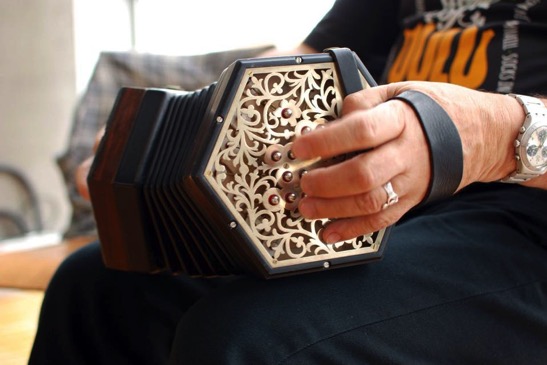Eight years have gone since the build, and the instrument has been played intensively – more than 3000 hours, as an estimate.

- in action at the Irish Festival of Oulu [photo: Evgenia Löfgren]
It is now clear to me that the following features: the angled hand-straps, the wider horizontal spacing between the buttons and the fact that they go all the way down to the end plate has contributed to, or facilitated, a different style of playing.
But its limitations have also started to reveal themselves – the sound is ”too much” in the low end and too little in the high. No – it doesn’t sound bad, it just doesn’t really sound like a concertina – it lacks the “crisp”. And it “muddles” a bit - rolls and triplets aren’t clear enough, they don’t stand out like they should.
But the outcome of the above features = a more elaborate fingering style, can actually can be applied to a traditional English concertina (a 48B, 1909 metal-end Wheatstone), and though the fingering is disturbed a bit by the uncomfortable closeness in the button cluster, it reveals that of rolls and triplets will sound much more crisp and clear with an instrument with concertina reeds.
And so?
So slowly, slowly, the idea of making a new instrument completely from scratch started to form. Listening to Geoff Crabb’s concertina making lectures at the Bradfield Traditional Music Weekends from 2006 to 2010 added the inspiration and did a lot to map out the size of the task. Retiring in 2010 added further inspiration!
So, here we are again! This time, though – since the last couple of years has been dedicated to making the tools – I will not go into all the details of that process but only show the finished tool “doing its thing” – including the mistakes! Most often, the nature of a mistake holds the solution for the improvement of the tool.
Next Previous